Effective Management of Dallisgrass: Top Weed Killers
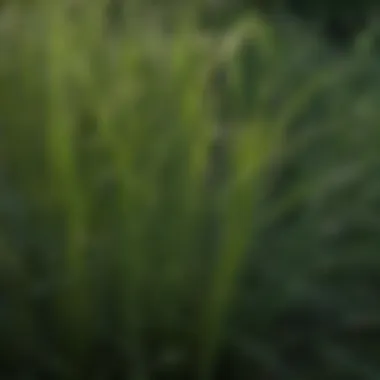
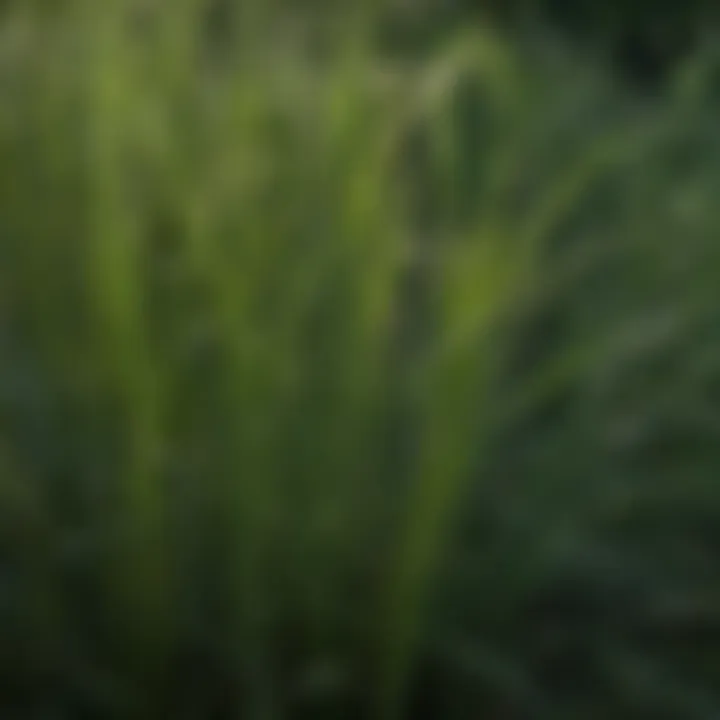
Intro
Dallisgrass, or Paspalum dilatatum, presents a ongoing challenge for turf farmers and agriculturalists alike. This perennial weed thrives in various environments, often outcompeting desired grass species and crops. Its deep-rooted nature makes it particularly resilient and difficult to eradicate. As such, effective management of Dallisgrass requires both understanding its growth patterns and identifying appropriate weed killers or control methods. This article aims to provide a comprehensive guide to managing Dallisgrass, emphasizing the latest strategies, innovations, and practical applications available at farmers' disposal.
Key Concepts and Terminology
Basic Definitions
Understanding key terms is essential when discussing Dallisgrass management. Dallisgrass is a warm-season perennial grass known for its vigorous growth and ability to tolerate drought conditions. It can spread through seeds or rhizomes, making it a formidable adversary in turf and crop management. Herbicides, which are chemicals designed to kill plants, are frequently employed in efforts to control Dallisgrass.
Historical Context
Historically, Dallisgrass was introduced to the United States from South America in the early 20th century. Initially, it was valued for its grazing potential in pastures. However, its aggressive growth soon led to its classification as a weed, particularly in non-grazing areas. Knowledge of its history can inform current weed management strategies.
Recent Innovations and Trends
Technological Advancements
The ongoing battle against Dallisgrass has spurred numerous advancements in weed management technology. Precision agriculture tools, such as GPS mapping and drones, allow farmers to identify and treat areas of infestation more effectively. This targeted approach reduces chemical use and improves efficacy. Moreover, new herbicide formulations are being developed that specifically target Dallisgrass while leaving desired grasses relatively unharmed.
Sustainable Practices
Alongside chemical control, sustainable practices are gaining traction. Integrated pest management (IPM) approaches combine biological, cultural, and mechanical methods. For instance, maintaining healthy turf through proper fertilization and mowing can help to suppress Dallisgrass growth. Additionally, the use of cover crops can improve soil health, preventing the establishment of weeds.
Practical Applications and Techniques
Step-by-step Guides
- Identify Dallisgrass: Confirm the weed's presence through visual inspection or consultation with local agricultural services.
- Select the Right Herbicide: Choose herbicides effective against Dallisgrass, such as glyphosate or dicamba. Always follow manufacturer instructions for application rates and timing.
- Apply at Optimal Timing: Target the weed during its active growth phase, typically in late spring or early summer.
- Monitor Effectiveness: After application, monitor the treated area for regrowth and take necessary corrective actions.
Case Studies
Several case studies illustrate successful Dallisgrass management. One farm in Texas utilized a combination of selective herbicides and cultural techniques to restore their turf. By altering mowing patterns and applying nitrogen-rich fertilizers, they managed to significantly reduce Dallisgrass presence while promoting healthy grass growth. This strategy minimized the economic outlay on herbicides and achieved long-lasting control.
Effective management of Dallisgrass integrates both chemical and non-chemical approaches. The aim is not only to kill the weed but also to foster a healthy, competitive turf.
Understanding the various management strategies and tools available for Dallisgrass control allows farmers and enthusiasts to adapt their approaches, ensuring both productivity and sustainability in their agricultural practices.
Understanding Dallisgrass
Understanding Dallisgrass is vital for effective weed management, particularly in agricultural and horticultural settings. Dallisgrass (Paspalum dilatatum) is a perennial weed that thrives in a range of environments. Its aggressive nature and ability to recover from disturbances complicate control efforts. By understanding its characteristics, farmers and gardeners can develop targeted management strategies. This section will explore the life cycle and growth habits of Dallisgrass, analyze its impact on agriculture and horticulture, and provide identification features to distinguish it from desirable plants.
Life Cycle and Growth Habit
Dallisgrass exhibits a complex life cycle that can make it quite challenging to manage. This weed typically germinates in the spring, capitalizing on warm soil temperatures. It grows vigorously during the summer months. Dallisgrass develops a deep root system which allows it to access water and nutrients from deeper soil layers. This growth habit gives it an advantage over shallow-rooted crops and ornamental plants. The plant can also reproduce both sexually, through seeds, and vegetatively via its rhizomes.
To effectively manage Dallisgrass, it is essential to consider its growth habit. Regular monitoring during its growing season can help identify infestations early. Additionally, understanding its life cycle can guide the timing of interventions, such as herbicide applications.
Impact on Agriculture and Horticulture
The presence of Dallisgrass can have significant detrimental effects on both agriculture and horticulture. In crop fields, it often competes with desired plants for valuable resources, including light, water, and nutrients. This competition can lead to reduced yields, particularly in corn and soybeans, where Dallisgrass presence is notable.
In turf management, Dallisgrass can create uneven surfaces and affect the aesthetic value of lawns and sports fields. Its ability to tolerate different mowing heights makes it persistent in managed turf systems. Therefore, addressing Dallisgrass not only improves crop outputs but enhances the overall quality of landscapes and recreational areas.
Identification Features
Identifying Dallisgrass correctly is a fundamental step in effective management. This weed has distinctive features that set it apart from other grass species. Notable characteristics include:
- Leaf Structure: Dallisgrass has wide, flat leaves that can reach lengths of up to 12 inches. The leaf blades are typically dark green and smooth, with a prominent midrib that runs along their length.
- Seed Head: The seed heads are often branched and can appear fluffy when mature. They emerge on long stems that rise above the leaves.
- Growth Form: It can grow up to 3 feet tall when fully matured, forming clumps that can spread both through seeds and underground rhizomes.
Recognizing these features can facilitate quicker interventions when dealing with infestations. Early identification is key to preventing Dallisgrass from establishing and spreading further.
Challenges in Controlling Dallisgrass
Controlling Dallisgrass presents several hurdles for farmers and horticulturists. Understanding these challenges is crucial for developing effective management strategies. Dallisgrass is particularly resilient, which complicates efforts to eliminate it. Ignoring these challenges can lead to increased competition for resources, resulting in reduced crop yield and quality.
The first major difficulty is the plant's ability to develop resistance to commonly used herbicides. Over time, repeated application of the same chemicals can upset the balance in the weed population. This factor prompts the need for varied strategies in weed management, ensuring that chemical methods remain effective over the long term.
Secondly, there is the environmental impact associated with herbicide use. Many synthetic herbicides can negatively affect non-target species and disrupt ecological balance. Their application must be carefully managed to minimize unwanted effects, particularly on beneficial insects and soil health.
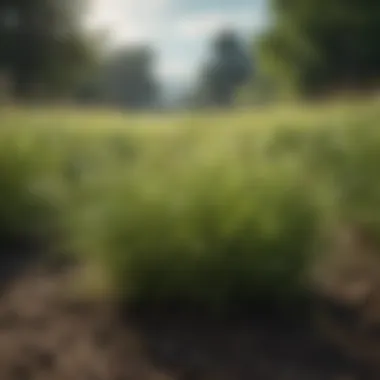

One cannot overlook the importance of understanding local ecology when addressing Dallisgrass control. The long-term success hinges not only on using the right weed killers but also on mindful application practices that consider surrounding flora and fauna.
Resistance to Common Herbicides
Resistance to herbicides is a growing concern in weed management. Dallisgrass shows a tendency towards developing resistance because of its genetic traits. Continuous exposure to the same herbicide component can lead to decreased effectiveness. In consequence, these weeds adapt more efficiently than anticipated, often requiring higher doses or new chemicals altogether.
- Points to note regarding herbicide resistance:
- Diversity in application: Employing a rotation of different herbicide classes can hinder resistance development.
- Integrated weed management: Combining chemical and non-chemical methods can reinforce approaches to minimize resistance risk.
- Monitoring: Regular assessment of weed populations helps identify resistance patterns early.
A proactive approach is essential. By incorporating varied management techniques, farmers can reduce dependency on any single herbicide class, ultimately preserving the effectiveness of available products.
Environmental Impact of Herbicides
The use of herbicides, while effective, carries significant environmental consequences. Many conventional herbicides can leach into the soil and water systems, potentially endangering aquatic ecosystems. Understanding these impacts is vital for sustainable agriculture.
- Key considerations regarding the environmental impact of herbicides:
- Runoff: Herbicides can easily wash away during rain, affecting nearby vegetation and wildlife.
- Soil health: Some chemicals might disrupt microbial populations in the soil, crucial for nutrient cycling.
- Biodiversity loss: Over-reliance on chemical controls can diminish plant diversity, leading to a less resilient ecosystem.
Farmers must balance effective Dallisgrass control with practices that minimize harm to the environment. Exploring organic options and integrated practices is a powerful step in promoting ecological health while managing weeds effectively.
"Sustainable practices ensure that the tools available today will still be effective tomorrow."
In summary, the challenges in controlling Dallisgrass are multifaceted. Resistance to herbicides can escalate, and environmental concerns must be addressed. Awareness and adaptation in management strategies are key to maintaining healthy crop systems.
Selecting the Best Weed Killers
Selecting the most appropriate weed killers is crucial for effective Dallisgrass management. The right choice not only reduces the weed population but also promotes the health of desired plants. Choosing an ineffective product can lead to increased resistance in the weed, causing more harm than good. The selection process considers various factors, such as the type of herbicide, crop safety, environmental impact, and application timing.
A well-chosen weed killer minimizes damage to the surrounding ecosystem, ensuring that beneficial plants are not harmed. Effectiveness also depends on understanding the specific growth habits of Dallisgrass and its response to chemical treatments. Therefore, having clear criteria for selection is essential for impacting overall results positively.
Criteria for Selection
When selecting a weed killer, certain criteria should be assessed. These include:
- Efficacy: The chosen herbicide must effectively target Dallisgrass without harming other plants.
- Safety: There needs to be consideration for the safety of ornamental plants and crops.
- Environmental impact: The herbicide should not have negative effects on soil health or nearby water sources.
- Application method: Compatibility with current equipment and methods affects ease of use.
- Cost-effectiveness: Budget considerations often dictate product choice, so value for money is important.
Types of Herbicides
Herbicides can be categorized into two main types, each with distinct functions and applications.
Selective Herbicides
Selective herbicides specifically target certain species of weeds without affecting other plants. This attribute is vital when managing Dallisgrass in turf or agricultural settings where maintaining desirable crops is necessary. These herbicides work by disrupting metabolic processes in targeted weeds, leading to their eventual death.
The main benefit of selective herbicides is that they provide strong control over Dallisgrass while preserving the surrounding vegetation. For example, products like Fusilade II can effectively manage Dallisgrass in established crops like soybeans and peanuts.
However, a disadvantage can be their potential ineffectiveness depending on the growth stage of Dallisgrass. It is critical to apply these at the right time to ensure maximum efficacy, which can complicate management timings.
Non-Selective Herbicides
Non-selective herbicides kill all kinds of vegetation they come into contact with, making them useful for total weed control. This characteristic can be effective for resetting areas heavily infested with Dallisgrass. One well-known product is Glyphosate, acknowledged for its broad-spectrum efficacy.
The primary advantage of non-selective herbicides lies in their ability to eliminate wide swathes of unwanted flora, providing a fresh start. This can be particularly useful in preparing fields before planting new crops. However, their disadvantage includes the risk of collateral damage to desirable plants, necessitating careful application methods.
"Choosing the appropriate herbicide is a balancing act between effectiveness on Dallisgrass and the potential harm to desirable plants."
In summary, understanding the differences between selective and non-selective herbicides aids in making informed choices. This knowledge can lead to a more effective management strategy against Dallisgrass.
Chemical Herbicides for Dallisgrass Control
Controlling Dallisgrass is not an easy task due to its vigorous growth and resilience. Chemical herbicides play an important role in the management of this weed. They are especially effective in areas where Dallisgrass spreads aggressively, causing harm to crops and turf. The right application of herbicides can reduce the competition Dallisgrass poses to desirable plants and improve overall crop yield and health.
Selecting the appropriate herbicide requires understanding the specific product and its effectiveness against Dallisgrass. Factors such as timing of application, environmental conditions, and the life cycle of the weed should be considered to maximize efficacy. This section discusses product recommendations, application guidelines, and necessary safety precautions to effectively use chemical herbicides against Dallisgrass.
Product Recommendations
Choosing the right herbicide is crucial for effective control of Dallisgrass. Here are recommended products:
- Glyphosate: A non-selective herbicide, it is effective but should be used cautiously as it may kill other plants.
- Sulfentrazone: Works as a pre-emergent and post-emergent herbicide, targeting established Dallisgrass effectively.
- Quinclorac: Known for its selective action, this herbicide is beneficial for use on established lawns suffering from Dallisgrass infestations.
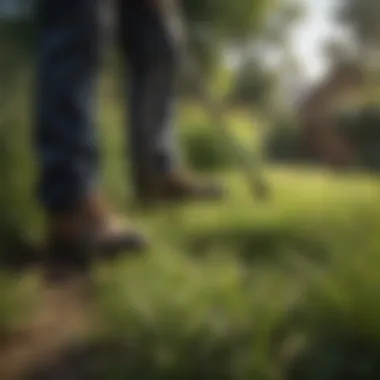

These chemicals have specific application guidelines and environmental considerations. It is essential to always consult the product label for detailed usage instruction.
Application Guidelines
Using herbicides correctly is critical for successful Dallisgrass management. Follow these guidelines:
- Timing: Apply herbicides early in the growing season, preferably when Dallisgrass is young and actively growing. This ensures maximum absorption and effectiveness.
- Concentration: Use the recommended concentration according to the product instructions. Overuse can lead to pesticide resistance and more harm than good.
- Weather Conditions: Apply on dry and calm days. Avoid windy conditions to minimize drift and prevent herbicide from affecting non-target plants.
- Equipment: Ensure that sprayers are calibrated correctly to achieve even coverage across the treatment area.
Following these application guidelines can make the herbicide treatment more effective and reduce the chances of Dallisgrass survival.
Safety Precautions
Safety is paramount when handling herbicides. Here are some important precautions to take:
- Personal Protective Equipment: Always wear gloves, masks, and eye protection when handling and applying herbicides.
- Storage: Store herbicides in a cool, dry place away from children and animals. Follow all safety instructions provided on the label.
- Disposal: Dispose of herbicide containers according to local regulations. Improper disposal can lead to environmental hazards.
- Monitoring Effects: After application, closely monitor the area for adverse reactions on desired plants and any signs of Dallisgrass resurgence.
Taking these precautions can significantly reduce risks to health and the environment.
Effective weed management is essential for maintaining agriculture and horticultural productivity, especially against persistent weeds such as Dallisgrass.
In summary, chemical herbicides provide significant benefits in controlling Dallisgrass when used wisely and with caution. Proper product selection, application techniques, and safety precautions all contribute to achieving optimal results in Dallisgrass management.
Organic and Alternative Weed Control Methods
Managing Dallisgrass effectively requires a holistic approach, which extends beyond traditional chemical herbicides. Organic and alternative methods offer an array of benefits that align with sustainable practices and environmental considerations. These methods not only target Dallisgrass, but also promote soil health and biodiversity. Understanding these approaches is essential for farmers and enthusiasts looking to implement strategies that can enhance their weed management protocols.
Natural Herbicides
Natural herbicides present a viable alternative for controlling Dallisgrass without resorting to synthetic chemicals. Derived from natural sources, these herbicides often pose fewer risks to non-target plants and ecosystems. Common examples include vinegar, clove oil, and citric acid. These substances disrupt the photosynthesis process in weeds or create an unfavorable environment for weed growth. Though typically less potent than their chemical counterparts, they can be effective when applied correctly and consistently. Their increased safety can encourage broader use in sensitive areas, such as gardens or organic farms.
Cultural Practices
Cultural practices encompass various agronomic techniques that assist in controlling Dallisgrass growth through management of the farming environment.
Mulching
Mulching serves as a protective layer over the soil and has been recognized for its multifaceted contributions to weed management. This method involves applying organic materials, such as straw or wood chips, which inhibit sunlight penetration. A key characteristic of mulching is its ability to suppress germination and growth of Dallisgrass seedlings. It is favored for its dual benefit: not only does it reduce weed pressure, but as it decomposes, it enriches the soil with organic matter. However, mulching requires upkeep; excessive thickness or inappropriate material can lead to fungal issues and moisture retention problems.
Crop Rotation
Crop rotation is a fundamental practice that can significantly affect weed dynamics, including Dallisgrass populations. By alternating different crops in a specific field during different seasons, the growth conditions for Dallisgrass can be disrupted. The key characteristic of crop rotation lies in its ability to confuse weed seed banks and reduce their prevalence. This method promotes soil fertility and minimizes pest and disease cycles. However, farmers must plan rotation sequences thoughtfully, as some crops may still favor certain weeds, requiring a balance in selection.
Biological Control
Biological control represents another layer of organic management where natural enemies of Dallisgrass are utilized for its suppression. This may involve introducing certain insects or pathogens that specifically target Dallisgrass, leading to a natural decline in its population. While this method is less common and requires more in-depth research and planning, it offers a promising avenue that aligns with ecological balance. Success in biological control is contingent upon maintaining the habitat for beneficial organisms and understanding their life cycles.
"Organic and alternative weed control methods can greatly enrich agricultural practices, promoting not only weed management but also overall ecosystem health."
In summary, adopting organic and alternative weed control methods can offer numerous benefits. Each strategy, from natural herbicides to cultural practices, allows for a proactive approach in managing Dallisgrass while remaining aligned with sustainable agricultural practices. This holistic view encourages further exploration and adaptation of these methods within local settings.
Integrated Weed Management Strategies
Integrated Weed Management (IWM) is a strategic approach that incorporates different management practices to control weeds more effectively. This method harmonizes chemical, cultural, and biological controls. Such integration offers a more sustainable solution, reducing dependence on any single method and mitigating the risks associated with herbicide resistance.
Adopting IWM in managing Dallisgrass is essential. It not only enhances weed control efficiency but also minimizes the environmental impact. By implementing multiple strategies, farmers and horticulturists can promote healthier crops. Additionally, IWM can improve the long-term health of the soil.
Combining Chemical and Cultural Controls
The approach of combining chemical and cultural controls is vital for effective Dallisgrass management. Chemical controls involve the use of herbicides, while cultural practices include methods like crop rotation, proper mowing practices, and soil management.
For instance, applying a selective herbicide designed to target Dallisgrass while preserving desirable plants is crucial. However, without proper cultural practices, the effectiveness may diminish over time. Herbicides should be used judiciously, considering their potential impact on non-target species.
Important considerations in combining these controls include:
- Timing: Applying herbicides during the Dallisgrass growth phase is critical.
- Cultural Practices: Incorporating crop rotation can disrupt Dallisgrass life cycle.
- Soil Management: Healthy soil can support robust plant growth, which helps in outcompeting Dallisgrass.
This combination creates a synergistic effect, whereby each method reinforces the other, leading to better management outcomes.
Monitoring and Assessment
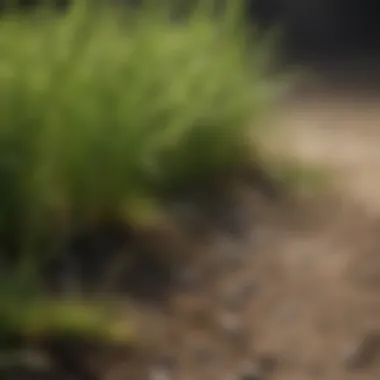
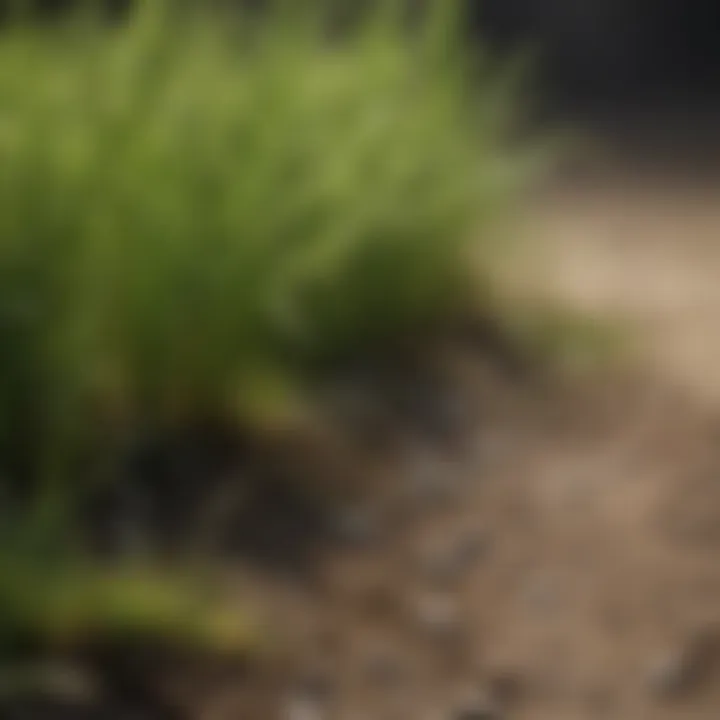
Monitoring and assessment are integral components of IWM. Effective weed management cannot occur without keeping track of Dallisgrass populations and evaluating control measures' effectiveness. This ongoing process allows for timely adjustments to management strategies.
Regular field observations should involve:
- Identifying Infestation Levels: Note the areas and density of Dallisgrass growth regularly.
- Evaluating Herbicide Efficacy: Determine if the selected herbicide is working as expected by observing grass health.
- Adjusting Techniques: If Dallisgrass populations are persisting, reconsider the herbicide or evaluate cultural practicies employed.
Monitoring helps build a comprehensive understanding of both the weed's patterns and the vulnerable points in management strategies. It offers data-driven insight, essential for refining future interventions.
In summary, integrating various methods in weed management is crucial in tackling Dallisgrass. The combination of chemical controls with strong cultural practices, along with routine monitoring, forms the backbone of a sustainable and effective weed management strategy.
Regional Considerations for Dallisgrass Control
Understanding regional considerations is crucial when managing Dallisgrass effectively. The characteristics of different regions, such as climate and soil types, significantly influence the growth of this weed and the methods used for its control. Adapting management strategies to regional specifics ensures better outcomes in both turf and agricultural settings.
Climate Impacts on Weed Control
Climate is a primary factor that affects not just the growth patterns of Dallisgrass but also the efficacy of various weed control methods. Warm, humid climates often favor the establishment and spread of Dallisgrass, as it thrives in such conditions. For instance, areas in the southeastern United States experience higher rainfall and warmer temperatures, which promote the aggressive propagation of this weed.
In contrast, regions that experience cooler temperatures or periods of drought can hinder Dallisgrass growth. However, it's essential to note that even in less favorable climates, Dallisgrass can still survive due to its deep-rooted systems. Therefore, understanding the climate you are in enables better timing for herbicide applications and other management strategies.
Moreover, seasonal changes can impact not just when to apply treatments but also how often monitoring is needed. Regions with distinct growing seasons will require different frequencies for weed assessments, ensuring that control measures are timely and effective.
"Knowledge of local climate patterns is key to formulating an effective approach to Dallisgrass management."
Soil Types and Their Influence
Soil type plays a pivotal role in the growth of Dallisgrass and the success of weed control strategies. Various soil types, such as sandy, clay, or loamy soils, interact differently with herbicides and natural control methods. Sandy soils, for instance, drain well but often lack nutrients, which can affect the establishment of desirable plants and facilitate Dallisgrass dominance. Areas with clay-rich soils tend to retain moisture, which could support a more robust growth of Dallisgrass, making it harder to control.
Furthermore, the pH level of the soil can impact the effectiveness of herbicides. Some herbicides work better in acidic soils, while others are more effective in neutral or alkaline conditions. Knowing the soil type and its pH can guide farmers in choosing the appropriate products and methods for controlling Dallisgrass.
In addition, soil compaction and fertility levels provide vital information that can influence management decisions. Compacted soils reduce the growth of desirable plants, allowing Dallisgrass to thrive. Employing proper cultural practices, like aeration and adding organic matter, can enhance soil health and suppress Dallisgrass growth.
In summary, regional considerations involving climate and soil influence every aspect of Dallisgrass control strategies. Tailoring methods to these factors not only leads to more effective management but also promotes healthier, sustainable agricultural systems.
Future Directions in Dallisgrass Management
Managing Dallisgrass effectively requires a forward-thinking approach. As the agricultural landscape evolves, so do the challenges presented by invasive weeds like Dallisgrass. Understanding the future directions in Dallisgrass management is crucial for farmers and horticulturists alike. This section examines new trends and innovations that may reshape how we approach Dallisgrass control.
Research on New Herbicides
The primary focus of ongoing research is the development of new herbicides specifically targeting Dallisgrass. Traditional herbicides often face issues such as resistance, reduced effectiveness, and environmental concerns. Researchers are now investigating compounds that leverage new modes of action. For instance, herbicides based on natural plant compounds show promise. They may provide more environmentally friendly options while effectively managing Dallisgrass.
Additionally, studies emphasize the importance of understanding the genetic makeup of Dallisgrass. By mapping its genome, scientists aim to identify vulnerabilities. This knowledge may assist in creating herbicides that selectively target the weed without harming desirable plants.
A key benefit of this research is the potential for tailored solutions. Customized herbicides can meet the specific needs of different agricultural systems, ensuring more effective control.
Innovations in Organic Controls
The shift toward organic farming has prompted innovative strategies for managing Dallisgrass. The focus is now on eco-friendly methods that minimize chemical usage. This includes the development of natural herbicides derived from plant extracts or microbial agents. Research is ongoing into how these products can disrupt the growth of Dallisgrass without negatively impacting the ecosystem.
Cultural practices are also gaining attention. Farmers are exploring more comprehensive integrated management strategies combining organic controls with traditional practices. For example, crop rotation and sustainable grazing methods are effective in disrupting the growth cycle of Dallisgrass.
The importance of education in adopting these innovations cannot be overstated. Training programs for farmers can encourage the use of these methods. By focusing on sustainable solutions, we can achieve long-term control of Dallisgrass.
"Innovative pest management strategies not only improve yield but also preserve the environment."
As we look ahead, the future of Dallisgrass management seems promising. With research and innovations focused on herbicides and organic methods, a more sustainable approach is becoming feasible. This will significantly contribute to preserving the integrity of our agricultural systems.
Epilogue
The importance of effective management of Dallisgrass cannot be overstated. Dallisgrass is not just an overlooked weed; it represents a substantial threat to crops and turf due to its rapid growth and resilience. Understanding how to manage this weed is crucial for agriculture as it directly impacts yield, quality, and overall ecosystem health. Moreover, improper management can lead to increased herbicide resistance and ecological imbalances.
This article has explored various facets of Dallisgrass management. We discussed criteria for selecting herbicides, highlighting that not all products are equally effective. The impact of Dallisgrass on agriculture has been addressed thoroughly, as well as its life cycle, which is fundamental for effective control strategies. The interplay of chemical and organic methods highlights the need for a comprehensive approach that considers both efficacy and safety.
Effective management also promotes sustainable farming practices. Proper weed control reduces the need for excessive chemical inputs, which can have detrimental effects on the environment. Thus, practicing integrated weed management can contribute to long-term agricultural sustainability and soil health.
"Effective weed management leads to healthier crops and better yields, allowing farmers to maximize their productivity while preserving the environment."
Summary of Key Points
- Dallisgrass Dynamics: The life cycle and growth habit make it a formidable opponent in fields and lawns.
- Management Strategies: Undertaking a combination of chemical herbicides and organic methods proves most effective.
- Environmental Considerations: Sustainable practices in weed management promote soil health and decrease reliance on chemicals.
- Integrated Approach: Utilizing multiple strategies achieves better long-term results against Dallisgrass.
Final Thoughts on Effective Management
Effective management of Dallisgrass is a multifaceted endeavor that requires careful planning and execution. Farmers must stay informed about the latest research on herbicides and organic alternatives. Furthermore, sharing experiences and results with colleagues can foster better tactics in local contexts.
Ultimately, diligent management is vital not just for the immediate benefits it provides but also for the ongoing health of agricultural systems. The hope is that through informed choices, the agricultural community can mitigate the invasive presence of Dallisgrass and maintain productive, healthy fields for future generations.















